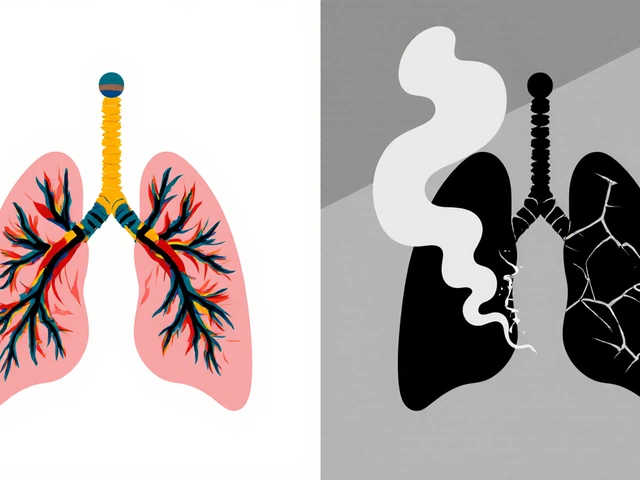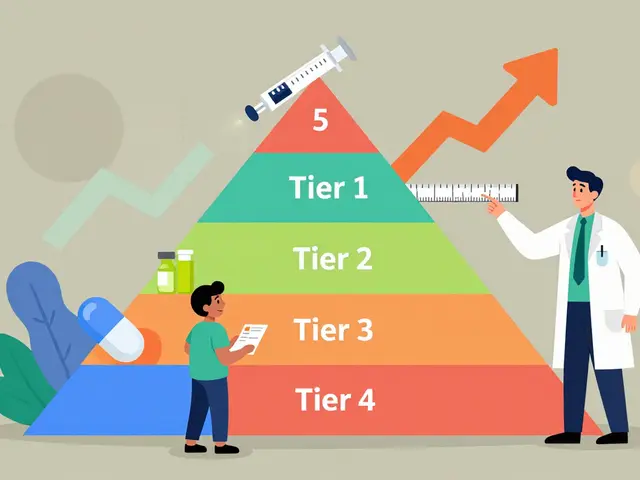HIV Regimen Comparison Tool
Compare HIV treatment regimens based on your health profile and preferences.
Quick Take
- Combivir combines lamivudine and zidovudine in a twice‑daily tablet.
- It is effective for treatment‑naïve adults but has a higher pill burden than newer single‑pill regimens.
- Common alternatives include Truvada, Atripla, and integrase‑inhibitor‑based combos.
- Resistance, pregnancy safety, and cost vary widely across options.
- Choosing the right regimen depends on viral load, comorbidities, and lifestyle.
When you search for "Combivir vs alternatives" you probably want to know whether that classic two‑drug pill still makes sense for you or someone you care about. Below you’ll find a plain‑English rundown of what Combivir actually is, how it stacks up against the most common modern regimens, and a simple decision guide to help you talk to your clinician with confidence.
What is Combivir?
Combivir is a fixed‑dose combination tablet that contains lamivudine (150mg) and zidovudine (300mg). It belongs to the nucleoside reverse‑transcriptase inhibitor (NRTI) class and has been on the market since the late 1990s.
Both components target the HIV reverse‑transcriptase enzyme, preventing the virus from converting its RNA into DNA. The result is slower viral replication and a higher chance of keeping the CD4 count stable when used as part of a fully suppressive regimen.
Key characteristics of Lamivudine and Zidovudine
Lamivudine, known by the generic name Lamivudine, is a well‑tolerated NRTI with a low toxicity profile. Zidovudine, also called Zidovudine, was the first approved antiretroviral and is effective but can cause anemia and neutropenia in some patients.
The combination allows twice‑daily dosing, which can be a hurdle for people who prefer once‑daily pills. Still, many patients appreciate the low cost of the generic version, especially in resource‑limited settings.
Modern alternatives you’ll hear about
Since the early 2000s, the HIV treatment landscape has shifted toward single‑tablet regimens (STRs) that bundle three drugs into one pill taken once a day. Below are the most frequently mentioned alternatives, each introduced with microdata for easy reference.
- Truvada - a combination of emtricitabine (200mg) and tenofovir disoproxil fumarate (300mg). Often paired with an integrase inhibitor like dolutegravir to form a three‑drug STR.
- Atripla - contains efavirenz (600mg), tenofovir (300mg), and emtricitabine (200mg) in a single tablet taken once daily.
- Dolutegravir - an integrase strand transfer inhibitor (INSTI) that can be paired with tenofovir and emtricitabine as a once‑daily STR (e.g., Biktarvy, though brand names are not listed here).
- Generic lamivudine + zidovudine - separate pills of the same doses as Combivir, allowing flexibility in dosing schedule but increasing pill count.
- Dolutegravir + lamivudine - a two‑drug regimen investigated for maintenance therapy in patients with suppressed viral loads.

Side‑effect snapshot
Every regimen comes with its own side‑effect profile. Here’s a quick look at the most common complaints:
- Combivir: anemia, neutropenia, gastrointestinal upset, potential lipodystrophy.
- Truvada‑based combos: renal tubular dysfunction, bone mineral density loss, mild nausea.
- Atripla: vivid dreams, central nervous system symptoms, rash.
- Dolutegravir‑based combos: insomnia, mild weight gain, rare hypersensitivity.
Understanding which side effects matter most to you helps narrow the field before you even sit down with a doctor.
How the options compare
| Regimen | Components | Dosing Frequency | Pregnancy Safety | Resistance Barrier | Typical Monthly Cost (USD) | Key Side Effects |
|---|---|---|---|---|---|---|
| Combivir | Lamivudine+Zidovudine | Twice daily | Category C - use when benefits outweigh risks | Low - both drugs have known resistance pathways | ~$20 (generic) | Anemia, neutropenia, nausea |
| Truvada+Dolutegravir | Emtricitabine+Tenofovir+Dolutegravir | Once daily | Category B - generally safe | High - integrase inhibitor adds robustness | ~$150 (brand) | Renal changes, insomnia, mild weight gain |
| Atripla | Efavirenz+Tenofovir+Emtricitabine | Once daily | Category C - caution advised | Moderate - efavirenz resistance can develop | ~$120 | Vivid dreams, rash, mild liver enzyme elevation |
| Generic Lamivudine+Zidovudine (separate pills) | Same as Combivir | Twice daily (two pills) | Same as Combivir | Same as Combivir | ~$20 | Same as Combivir |
| Dolutegravir+Lamivudine | Dolutegravir+Lamivudine | Once daily | Category B - considered safe | High - dolutegravir’s barrier is strong | ~$80 | Insomnia, mild headache |
Who should stay on Combivir?
If you’re already virally suppressed on Combivir, there’s no medical urgency to switch. The regimen’s low price can be a lifesaver in countries where insurance coverage is limited. It also works well for patients who cannot tolerate integrase inhibitors due to drug‑drug interactions, such as those on certain anticonvulsants.
However, if you’re starting therapy for the first time, consider the following:
- Pill burden - If twice‑daily dosing feels daunting, an STR may improve adherence.
- Pregnancy plans - Zidovodine is Category C; many clinicians prefer tenofovir‑based combos for pregnant individuals.
- Kidney function - Tenofovir can affect renal labs, while zidovudine mainly influences blood counts. Choose based on your lab profile.
- Resistance history - If you’ve been on NRTIs before and harbor M184V or thymidine analog mutations, the effectiveness of lamivudine+zidovudine may be reduced.
Practical tips for making the most of your regimen
- Take Combivir with food to reduce stomach upset.
- Schedule a complete blood count every three months while on zidovudine.
- If you experience fatigue, ask your clinician whether a switch to an integrase inhibitor could help.
- Never stop medication abruptly. Even a missed dose can give the virus a chance to rebound.
Frequently Asked Questions
Is Combivir still recommended in 2025?
Combivir remains a viable option for patients who need a low‑cost regimen and for those who cannot use newer drugs due to interactions or intolerance. Guidelines now prefer once‑daily STRs for most treatment‑naïve adults, but the drug is not obsolete.
Can I switch from Combivir to a single‑tablet regimen?
Yes. A clinician can transition you to a regimen such as dolutegravir+emtricitabine+tenofovir, often after confirming that your viral load is undetectable. The switch usually involves a short overlap period to avoid resistance.
What should I monitor while on Combivir?
Regular complete blood counts (CBC) are essential because zidovudine can lower hemoglobin and neutrophils. Liver enzymes should also be checked every six months.
Are there any food restrictions?
Take Combivir with a meal or snack to lessen nausea. No specific foods need to be avoided, but maintaining a balanced diet supports overall health.
How does cost compare to newer drugs?
The generic version of Combivir typically costs under $30 per month in the United States, whereas branded STRs can exceed $150 per month. Insurance coverage and regional pricing can shift these numbers, but generics stay the most economical.

Next steps
Talk to your HIV specialist about your current viral load, kidney and blood‑count results, and any upcoming life events (like pregnancy). Bring this comparison sheet to the appointment; it can spark a focused discussion about whether staying on Combivir or switching to an STR makes the most sense for you.
Remember, the best regimen is the one you can take consistently, that keeps the virus suppressed, and that fits your health profile. Use the information here to ask clear questions and make an informed choice.







Annie Tian
September 30, 2025 AT 13:14Laying out the key differences; the table makes it easy to compare dosing schedules, side‑effect profiles, and costs-all at a glance. Your clear headings and bullet points really help readers who may be overwhelmed by medical jargon, and the practical tips at the end are especially valuable. Keep sharing these concise, well‑structured guides; they make a huge difference for anyone navigating treatment choices.
April Knof
October 7, 2025 AT 13:14It’s also worth noting how access to generic Combivir varies across regions; many low‑income countries rely on it because the cost barrier for branded STRs remains prohibitive. Highlighting insurance coverage differences and pharmacy availability can further empower patients to discuss realistic options with their clinicians. Your guide already touches on cost, but a brief note on global supply chains would round it out nicely.
Tina Johnson
October 14, 2025 AT 13:14One important issue that is often overlooked is resistance testing before initiating any NRTI‑based regimen. In clinical practice, overlooking pre‑existing M184V mutations can render lamivudine ineffective, thereby compromising viral suppression. Moreover, the presented cost comparison fails to account for hidden expenses such as routine laboratory monitoring required for zidovudine‑induced cytopenias.
Sharon Cohen
October 21, 2025 AT 13:14Even the most thorough guide cannot mask the heartbreak of patients forced into a twice‑daily regimen by insurance constraints.
Rebecca Mikell
October 28, 2025 AT 12:14Balancing scientific detail with patient‑focused advice, especially the “practical tips” section, helps readers implement recommendations. Such actionable suggestions bridge the gap between theory and everyday life, making the information truly usable for people managing HIV day‑to‑day. The balanced tone respects both the pros and cons without pushing a single agenda.
Ellie Hartman
November 4, 2025 AT 12:14For newcomers, it might help to add a quick checklist: verify pregnancy status, review recent CBC results, and confirm renal function before deciding between Combivir and a newer STR. A concise “pre‑visit” list can streamline conversations with providers and reduce the anxiety that often accompanies regimen changes. This small addition would complement your existing advice nicely.
Alyssa Griffiths
November 11, 2025 AT 12:14There is a hidden agenda driving the promotion of newer, patent‑protected single‑tablet regimens that the article fails to acknowledge; pharmaceutical corporations spend billions lobbying regulators, and the resulting guidelines often favor brand‑name drugs over affordable generics. While the efficacy of these STRs is comparable, the financial incentives for prescribers can subtly influence prescribing patterns, especially in for‑profit healthcare systems. Furthermore, the so‑called “high barrier to resistance” of integrase inhibitors is not absolute-resistance mutations have been documented in patients with sub‑optimal adherence, undermining the claim of invulnerability. The cost analysis presented omits the long‑term economic impact of managing side‑effects such as renal toxicity associated with tenofovir, which may lead to additional specialist visits and laboratory tests. In many low‑resource settings, the supply chain for branded STRs is fragile, resulting in treatment interruptions that can precipitate resistance development. It is also concerning that the article does not discuss the environmental footprint of manufacturing complex, multi‑component pills, a factor increasingly relevant in global health debates. The emphasis on “once‑daily convenience” overlooks the fact that adherence is multifactorial, involving patients’ daily routines, stigma, and mental health, not merely pill count. Moreover, the brief mention of pregnancy safety ignores the nuanced teratogenic data emerging from recent cohort studies, which suggest a need for ongoing vigilance. The statement that zidovudine is merely “Category C” belies the extensive historical data on its hematologic toxicity, which can be particularly problematic in pregnant women already at risk for anemia. While the table lists typical monthly costs, it fails to account for insurance co‑pays, pharmacy mark‑ups, and patient assistance programs that dramatically alter out‑of‑pocket expenses. The article also neglects to address the role of therapeutic drug monitoring, an essential tool for optimizing dosing in patients with renal impairment or drug‑drug interactions. Critics may argue that the piece is balanced, yet the placement of certain regimens in the “recommended” list reflects a bias toward newer formulations without robust justification. It would be prudent for readers to question why the author did not cite any independent cost‑effectiveness studies, especially when discussing public health policy implications. Finally, acknowledging the historical significance of Combivir as a lifesaver in the early AIDS epidemic can provide context, reminding us that “newer is not always better” in the complex landscape of HIV therapy. Patients deserve transparent information so they can make informed choices without undue corporate influence.
Jason Divinity
November 18, 2025 AT 12:14Cautionary tones can sometimes lead to undue alarm among patients; the scientific literature supports the safety of modern STRs when monitored appropriately. A balanced discourse should recognize that pharmaceutical innovation, albeit profit‑driven, has yielded regimens with superior tolerability and adherence benefits. Moreover, the claim that “newer is not always better” ignores the robust data from large‑scale trials demonstrating reduced resistance rates with integrase inhibitors. Let us ground our debate in evidence rather than speculation, thereby empowering clinicians and patients alike.
andrew parsons
November 25, 2025 AT 12:14In truth, cost considerations must dominate every treatment decision; 🏥💸
Sarah Arnold
December 2, 2025 AT 12:14The key takeaway is to align regimen choice with individual lab results, lifestyle, and financial resources; a simple decision tree can guide patients toward the most suitable option without overwhelming them. 📊💊
Rajat Sangroy
December 9, 2025 AT 12:14Don’t let the fear of “old‑school” pills hold you back-Combivir can be a powerful, cost‑effective ally if you stay on top of blood work and maintain strict adherence!
dany prayogo
December 16, 2025 AT 12:14Oh, absolutely, because nothing screams “progress” like clinging to a regimen from the 90s while the rest of medicine races ahead. You’re right to assume that patients love counting pills twice a day and battling anemia-who needs convenience when you can have nostalgia? The idea that a cheap generic could save a household’s budget is just a myth, clearly invented by those who don’t understand the “real” value of brand‑name hype. And let’s not forget the thrill of weekly blood draws; they add that extra pinch of excitement to an otherwise dull routine. So yes, keep praising Combivir as if it were the Holy Grail, because ignoring advancements is the true mark of dedication, isn’t it?
Wilda Prima Putri
December 23, 2025 AT 12:14Sure, because who doesn’t love juggling more pills for the same effect.